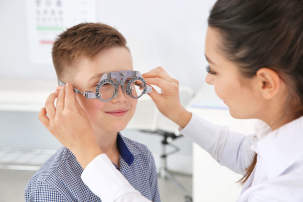
Laser vision correction — why isn’t it performed in children? |
| 30.05.2022 |
 Children are usually very active and may find glasses inconvenient while having fun or playing football. Contact lenses are not the best solution for them either for they increase the risk of eye infections, e.g. when eyes are rubbed with dirty hands.
Children are usually very active and may find glasses inconvenient while having fun or playing football. Contact lenses are not the best solution for them either for they increase the risk of eye infections, e.g. when eyes are rubbed with dirty hands.
Laser vision correction is a perfect way of freeing oneself from the necessity of wearing glasses or contact lenses, yet the surgery may only be performed in adult patients (the minimum age is 18 years). Why isn’t it possible for children to have the procedure? Let us explain it below.
The eye undergoes intensive growth from the moment of birth. Then, among other things, the length of the eyeball and the diameter of the cornea increase. The size of the eyeball and the value of eye refraction are influenced by genetic and environmental factors (such as the time spent looking at close range objects).
One of the conditions for positive qualification for laser vision correction is the stability of the refractive error. At the stage of a child’s growing up, it is impossible to predict whether the defect will continue to accompany them in adulthood or whether its value will change to a higher one (i.e. will become more severe).
We assume that the eyeball develops approximately until the age of 18, and the defect stabilises at about 20 –the age at which it is worth considering the surgery. It is recommendable to present previous ophthalmological examination results or a prescription for glasses or contact lenses during the preliminary qualifying examination so the ophthalmic surgeon can determine if the defect is stable.
Amblyopia is caused by any condition that interferes with the development of visual acuity during childhood. Therefore, incorrect vision is not necessarily caused by a vision defect, but by the fact that the brain does not process the stimuli provided by the eye.
Amblyopia is not easy to diagnose, which is why the child must be examined by an ophthalmologist at the age of about 4. Only when amblyopia is detected and treated in time (e.g. by stimulating the weaker eye), it increases the chances of correct vision in the future.
If amblyopia is not diagnosed in childhood (approximately up to the age of 7), in adulthood it may hinder obtaining a driving license, getting a job in uniformed services and even performing simple daily activities.
Amblyopia cannot be corrected with corrective lenses or through laser vision correction, either in children or in adults.
If you are at least 18, you can make an appointment for a qualifying examination or a one-day procedure (examination and surgery on the same day) by completing the online qualification form or via phone or email. Younger patients (over the age of 10) can make an appointment for a specialist ophthalmologic examination to check the eyes for vision defects, assess the eyes’ general condition, and choose suitable correction if necessary.